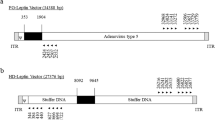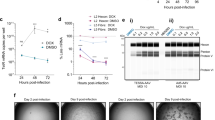Abstract
Recombinant adenoviral vectors are being used extensively for gene transfer. During the construction of an E1-deleted virus expressing the human B7-1 gene, an aberrant recombinant (Ad.ihB7-1) arose with an unusual 5′ sequence. Characterization and sequencing of Ad.ihB7-1 showed that its structure was the result of both homologous and nonhomologous events. The most striking features of the construct were the incorporation of bacterial genomic DNA, an additional inverted terminal repeat, and portions of E1a. The appearance of this construct has implications for vector design and indicates the need for careful analysis and characterization of recombinant adenoviral vectors for clinical use.
This is a preview of subscription content, access via your institution
Access options
Subscribe to this journal
Receive 12 print issues and online access
$259.00 per year
only $21.58 per issue
Buy this article
- Purchase on Springer Link
- Instant access to full article PDF
Prices may be subject to local taxes which are calculated during checkout
Similar content being viewed by others
Author information
Authors and Affiliations
Corresponding author
Rights and permissions
About this article
Cite this article
Smith, J., Eck, S. Molecular characterization of an adenoviral vector resulting from both homologous and nonhomologous recombination. Cancer Gene Ther 6, 475–481 (1999). https://doi.org/10.1038/sj.cgt.7700062
Received:
Accepted:
Published:
Issue Date:
DOI: https://doi.org/10.1038/sj.cgt.7700062



